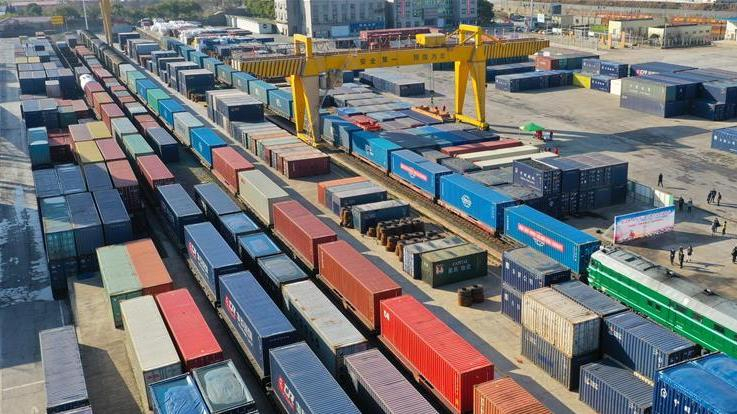
Editor's note: Hannan Hussain is a foreign affairs commentator and author. He is a Fulbright recipient at the University of Maryland, the U.S., and a former assistant researcher at the Islamabad Policy Research Institute. The article reflects the author's opinions and not necessarily the views of CGTN.
A new report published by The Financial Times on December 12 claims to forecast the "unraveling .. [of] China's first overseas debt crisis," alleging that the wheels of the Belt and Road Initiative "have come off."
"China's rethink betrays a tacit recognition that its overseas lending bonanza has been ill-conceived," states the report. Having cherry-picked statistics and measured BRI's global impact against less representative, singular benchmarks, the report reveals a partisan bend against the BRI's scope, growth and global reception.
In what is described as a reality that deviates sharply from Chinese President Xi Jinping's BRI vision, the report cites lending data by Chinese financial institutions from Boston University researchers. Authors of the report immediately conclude that Chinese institutional lending, under the BRI, took a nosedive last year – falling by an approximated margin of 94 percent from 2016.
There are several problems with this self-identified collapse narrative, beginning with a blind-eye to BRI's actual project-to-project valuation. As of September 2020, financial market data giant Refinitiv estimated that the collective value of belt and road projects stood at $2.41 trillion. This figure, counting over 2,000 active BRI projects worldwide, offers a glimpse into the initiative's demonstrated resilience in the midst of the on-going pandemic, especially when the trillion-dollar valuation exceeds the combined worth of other independent projects pursued by China outside BRI.
Thus, any attempts to project Chinese institutional lending under the BRI as some sort of a "retreat" should first be supported by evidence that the project's collective value is taking a hit of any kind. Judging by its own conclusions, the Financial Times report makes no attempt to derive these correlations and, by doing so, establishes a classic case of motivated reasoning.
The second problem concerns the report's context – touted by authors as a crucial justification to substantiate the BRI's alleged decline. At the heart of this crucial context lies an unwarranted contest between the World Bank's annual overseas lending and that of the China Development Bank and the Export-Import Bank of China. "Such a sharp scaling back of lending by the Chinese banks amounts to an earthquake," rules the report.

The China-Europe freight train waiting for departure at Xiangtang railway port in Nanchang, east China's Jiangxi Province, February 17, 2020. /Xinhua
The China-Europe freight train waiting for departure at Xiangtang railway port in Nanchang, east China's Jiangxi Province, February 17, 2020. /Xinhua
However, the comparison is self-manufactured and not part of China's strategic BRI vision at all. The success of BRI continues to be grounded in global connectivity and is not measured in terms of overseas-lending-rivalry with Western financial institutions. Therefore, by misreading the determinants of China's dual circulation policy and transforming the Belt and Road Initiative into an ideological pursuit with the West, little of the published conjecture passes the test of critical examination.
On the crucial question of debt-sustainability, China offers a customized approach to debt management that is in line with the distinct debt-servicing capacities of numerous countries. This well-established foresight is also spun out of proportion in the report in a bid to back the BRI-in-decline narrative. For instance, the BRI's embrace of all government types is pronounced as "the program's fatal flaw." The report further construes China's debt renegotiations, with a dozen countries this year, as a sign of pandemic opportunism. "Debt renegotiations have proliferated as the pandemic has clobbered emerging economies in Africa and elsewhere – at least 18 processes of debt renegotiation with China have taken place in 2020 and 12 countries were still in talks," asserts the report.
As far as the statistical strength of the above assertion is concerned, an October report by Rhodium Group forms the gist of its implicit conclusions. Rather ironically, the full stretch of Rhodium's evidence-base suggests that it doesn't subscribe to overdrawn narratives about BRI's alleged retreat, nor does it indicate approval of any fatal debt-renegotiation paradoxes that could harm global transparency.
Instead, it brings into focus a range of leadership variables that are lost on the Financial Times report. These include China's separate agreements with nearly a dozen Debt Service Suspension Initiative (DSSI) eligible countries, Chinese government's continued willingness to write-off debts for nations in need, grace period extension prospects, and headways on recently concluded negotiations. More importantly, they align with further trade and investment findings from the World Economic Forum, the Pew Research Center, The World Bank, and even the U.S. Federal Reserve.
Ultimately, the idea that the BRI is taking a hit against its stated objectives is nothing but a distorted narrative which is at odds with ground realities. As partner countries reciprocate China's trust in win-win cooperation, there is little space for unwarranted speculation masquerading as credible.
(If you want to contribute and have specific expertise, please contact us at opinions@cgtn.com)

